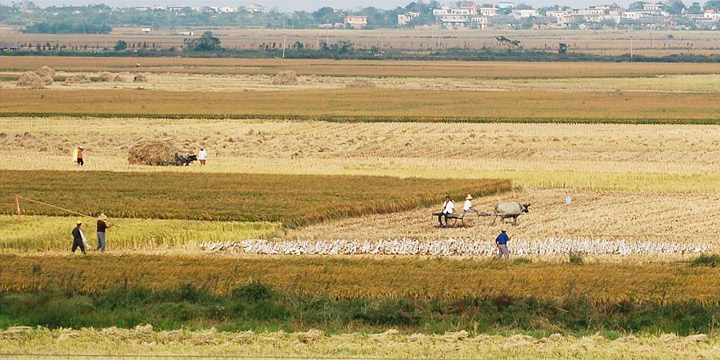

In the mid-1990s, highly pathogenic avian influenza (bird flu) emerged in southern China. Severe outbreaks in the winter of 2005-2006 spread the virus, designated H5N1, across Asia, Europe, and Africa, killing hundreds of people, thousands of wild birds, and millions of poultry. In fall 2009, scientists and public health officials continued to watch H5N1 closely for signs that, like H1N1 (“swine flu”), it had evolved into a form capable of creating a pandemic.
Landscape ecologist Xiangming Xiao of the University of Oklahoma is part of a large group of scientists from U.S. and international scientific and public health organizations who are trying to predict areas at high risk for future avian influenza outbreaks. Xiao and his team use satellite images to map the location of rice paddies and wetlands in China and Southeast Asia, something that Landsat images will allow them to do in much more detail.

“Harvested rice paddies have become a stage where wild water birds, which naturally carry low pathogenic types of the virus, and domestic ducks mix,” explains Xiao. “In that mixing, virus transmission might occur.” As the virus spreads among species, the possibility for evolution into a highly pathogenic type of flu increases.
Xiao starts his analysis of satellite images by having computers identify areas with a unique seasonal pattern: a period where the satellite sees only water, followed by a mix of water and vegetation, followed by a period where all the satellite sees is vegetation. “This sequence—water, mix, no water—is unique to rice paddies,” explains Xiao.
Xiao currently uses observations from the MODIS sensor on NASA’s Terra satellite for this stage of the analysis because it depends on frequent images of the same area. MODIS provides daily observations of most places on Earth, but the images show only a moderate amount of detail. “In many cases, rice paddies are smaller than the 250-meter pixels in the MODIS images,” explains Xiao, “and we miss them.”

This is where the Global Land Survey 2005 collection will contribute substantially. Xiao and his team are starting to combine radar images from the ALOS/PALSAR mission of Japan with Landsat images from the Global Land Survey to identify and map paddy rice and wetlands with much greater detail than they could before.
“We need that kind of detail to better understand how and when the birds are moving among the different habitats where they can acquire or transmit the H5N1 virus,” says Xiao.